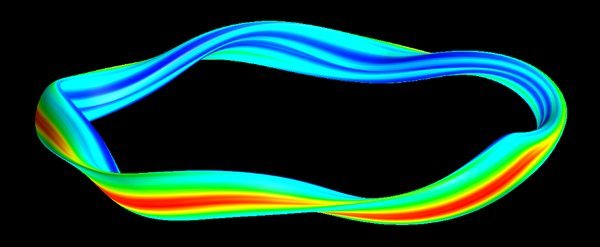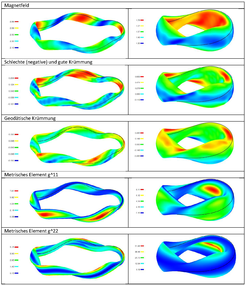
Modeling and Optimization of Gyrokinetic Turbulence in Stellarators
The project involves the massively-parallel Eulerian nonlinear gyrokinetic code GENE coupled to the geometry interface code GIST.
Both codes are developed at the Max-Planck-Institute for Plasma Physics in Garching and Greifswald. Areas of interest cover stellarator transport modeling, turbulence optimization and statistics, in contact with several collaborators.
Description of GIST code
The code GIST (Geometry Interface for Stellarators and Tokamaks) has been designed to provide the nonlinear gyrokinetic solver GENE with the necessary geometric information, in order to perform simulations in an arbitrary toroidal plasma with closed flux surfaces. GIST reads in a wout.txt file from the VMEC equilibrium code (at present the versions 6.90, 8.00, 8.46 up to 8.50 are supported) or an EFIT file for tokamak applications. Based on this information, GIST generates the geometry either for a flux-tube (a computational box surrounding a single magnetic field line on a prescribed flux surface) or an ensemble of tubes covering a selected magnetic surface (to be used with the full-surface GENE code). GIST is extensively documented, maintained under subversion (svn) control and available through contact: Pavlos Xanthopoulos (for contact see the container in the right column).
GIST User Manual
detailed documentation: P. Xanthopoulos, W.A. Cooper, F. Jenko, Y. Turkin, A. Runov and J. Geiger “A geometry interface for gyrokinetic microturbulence investigations in toroidal configurations” PoP 16, 082303 (2009)).

Full-surface GENE code
Main thrust of the GENE development for stellarator applications is the extension of the original local model (based on the 'flux-tube' concept) toward the full-surface model, covering an entire stellarator surface (of infinitesimal radial extent) per simulation. The importance of this approach lies in the fact that, in a non-axisymmetric configuration, the individual flux-tubes usually have measurably different properties regarding micro-instabilities and the associated turbulence.
The following picture depicts the electrostatic rms-density fluctuations caused by ITG turbulence on one W7-X toroidal period (left, the unwrapped surface). Note that the fluctuations reside mainly along a thin band on the outboard side of the configuration.

This feature is in stark contrast to the tokamak case (shown below), where strong fluctuations are present all over the outboard side, where curvature is unfavorable. It should be noted that the variation of the fluctuation amplitude is much smaller in the axisymmetric configuration that in W7-X.

A movie (see the Link in the right column) shows the time evolution of the ITG density fluctuations on a W7-X magnetic surface.


